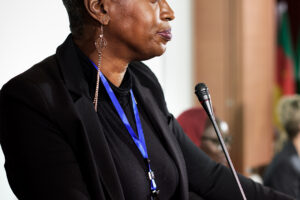Brain Drain in Africa: Issues and Challenges in the Context of Higher Learning in Cameroon.
Capuano and Marfouk (2013) report that many African economies are continuing to lose skilled labour to the developed world, despite Das having raised concern about this phenomenon more than 40 years ago. In addition, Das (1971) explains that, although African students studying in countries like the United States of
America have the desire to return home after completing their studies, their decisions are influenced by the dynamics of the labour market in each country. A case in point is the Kenyan economy where the diaspora, through remittances, improved the real estate investment and other sectors (Bamahriz and Masih 2018). In relation to the brain drain as it relates to women and the medical profession, Capuano and Marfouk (2013) suggest that the existing trend in Africa is likely to get worse. In their view the ongoing socio-political and security crises in many African countries, including Cameroon is exacerbating the situation. Increasing the rate of brain drain has negative implications for African countries in terms of losing human capital and resources that were invested in training these professionals (Kaempf and Singh 1987; Rizvi 2005; Docquier et al. 2007; Capuano and Marfouk 2013). Morocco is an example of an African country that spends a great deal on education without reaping the dividends of this investment, as its trained professionals prefer to migrate to other parts of the world rather than staying in Morocco (Nechad 2018). Another challenge faced by African countries is that, due to the nature of their economies, the workforce that has been trained cannot be absorbed, which causes many graduates to migrate to other parts of the world in search of work (Kaempf and Singh 1987). Docquier (2014) cautions that migration may escalate in situations of war and insecurity,
which is applicable to the case of Cameroon. Based on brain-loss-brain-gain rhetoric (Martineau et al. 2004), Das (1971) questions the recurrent notion that developed countries are robbing developing countries of their human resources. In Das’s (1971) view, many professionals migrate because the economies of their home countries do not possess conditions favourable for their employment – this claim is reinforced by recent protests in Cameroon by about 200 PhD holders, caused by lack of employment opportunities (Chimtom 2019). These events align with the view of Arocena and Sutz (2006) that when people with knowledge and capabilities do not have opportunities that enable them to put their skills to use, they are likely to look
elsewhere, and these opportunities are more likely to be in the developed world. In essence, African countries need to create an atmosphere that is receptive to their citizens who have acquired specific professional skills either at home or abroad. Mberu and Pongou (2016) agree that creating such conditions will enable the harnessing and use of existing skills appropriately for national development in the countries of origin of professionals.
Docquier (2006: 1) explains that skilled professionals can make enormous contributions to areas such as “quality governance and increasing return on education”. The United Nations (UN) (2008) reveals that a receptive atmosphere will enable these professionals to act as engines of growth in their home countries. In addition to gaining direct employment, these professionals can give back through entrepreneurial skills (UN
2008). However, the success of this approach depends on the nature of laws governing businesses in individual African countries that allow people, especially those in the diaspora, to invest their skills. Carrington and Detragiache (1998) surmise that the diaspora population is likely to be more educated than the population back in the home country, hence the need to create conditions that would enable the diaspora population to contribute to development in their home country.
In light of the ambiguities associated with the brain drain phenomenon (Das 1971), the authors of this paper have coined the term “artificial” brain drain to emphasise factors that are human-made, as opposed to those that are natural. Artificial brain drain refers to instances where the skilled population is forced to migrate
to other countries due to dire socio-political and economic situations in their home countries which are, in most cases, the result of the actions, or lack of action, by people in power. In contrast, natural brain drain refers to those factors that are caused by natural disasters, and are completely beyond the control of the people who migrated.
The authors argue that centralising recruitment for institutions of higher learning in Cameroon – as well as the great deal of documentation, which can be discouraging, therefore restrict some skilled professionals who wish to apply for these positions, especially those in the diaspora. This has implications for universities and the economy as a whole. For example, the Cameroon central government decides when universities should recruit, and prescribes the number of new staff per department, irrespective of the needs of these universities (Sina 2018). It can be argued that there is no doubt that the dependency of universities on the political will
of the central government to initiate massive recruitment processes, and to make appointments, negatively affects the functionality and output of these universities.
Objectives
Against this background, the specific objectives of this paper were to interrogate the nature of recruitments and appointments in Cameroon’s state universities and to explore the way the highly bureaucratic system of governance exacerbates the brain drain in Cameroon.
METHODOLOGY
In this qualitative and exploratory study, the authors interrogate the phenomenon of brain drain in Africa, with a focus on the context of its implications for state universities in Cameroon. An interpretivist paradigm was assumed, as the authors sought to understand the socially constructed reality immersed in the data set (De Voset al. 2011). Qualitative content analysis was the methodology employed. Nieuwenhuis (2007) contends that content analysis involves looking at data from different angles, with a view to identifying keys in the text that will help to make meaning of the raw data. The ‘keys in the text’ referred to above is what Stemler (2001: 1) considers as “compressing many words of text into fewer content categories, based on explicit rules
of coding”.
The qualitative content analysis procedure involved selecting units of analysis and the process of making meaning of the data (Elo and Kyngas 2008). The units of analysis selected were official documents sourced through a desktop research process. The main document was the 2018 presidential decree that ordered the recruitment of PhD holders into state universities in Cameroon. Although other decrees of similar nature were issued in previous years, that of 2018 is used to contextualise this paper and others are only referred to in order to buttress arguments as the need arises. Like a domino effect of this presidential decree, the various state universities followed up with media releases that echoed the government’s call, while universities placed emphasis on the numbers needed by specific departments at each university. Therefore, the content of the central decree and the universities’ releases were analysed for convergences and divergences. Moreover, sources were consulted such as ministerial releases, online newspapers and other media sources, concerning the appointment of administrators into different echelons of the management structures of state universities in Cameroon. The key question underpinning our investigation was: How does the nature of recruitment for and appointments into state universities in Cameroon contribute to brain drain? This key question directed the meaning-making process of the data. Informed by this question, the researchers made sense of the data by open coding the different documents and creating specific categories. The coding and categorisation produced themes that were abstracted, and are presented as findings below. Also important is the use of the emic perspective (Markee 2012), by which the authors ensured that, as insiders in the study, their subjective views of the reality of the phenomenon were involved in the research process as a point of analytical departure. This implies that, to some limited extent, their experiential knowledge of th context and phenomenon under study was considered in the analysis.
RESULTS AND DISCUSSION
This section will present the findings and discussions of the study. The recruitment of university lecturers (processes and documentation) and the appointment of university administrators through presidential decree emerged as human-made factors that contribute to exacerbating brain drain in Cameroon. First there is a brief analysis of two previous recruitment events that had implications for higher education: the 2011 recruitment of 25 000 graduates (Kendemeh 2011) and the 2018 recruitment of researchers (Sina 2018).
Recruitment of Lecturers
In 2011, the Prime Minister and Head of Government at the time, Philemon Yang, put in place a 15-member commission to manage the recruitment of 25 000 graduates into the public service, as mandated by the executive arm of the government. The secretary in the prime minister’s office and his deputy were dedicated as chairperson and vice chairperson of the commission respectively. Ironically, the committee selected candidates and then distributed them among the various state universities (Muluh 2011; MINESUP 2018), irrespective of the priorities of universities. It is not clear what proportion of the 25 000 graduates were absorbed into the higher education space as lecturers, although, since then, no other recruitment has been done until the last call of 2018. Logically, the gap of seven years between recruitment events is too long for a country that has a high unemployment rate but produces skilled professionals, and which considers itself as emerging. The employment approach in place restricts Cameroon’s state universities from recruiting the personnel they need, and ignores their needs. In a recent media release for the recruitment of 150 researchers in Cameroon, the advertisement reserves 30 positions for Cameroonians living outside the country, irrespective of skilled graduates available locally and the needs of universities (Ahone 2019). Compared to previous years, this advertisement is more accommodating; for the first time, it allows Cameroonians out of the country to deliver the required documentation at the closest Cameroonian embassy. However, it is unclear whether the documents required in the past still numbered 14. In addition to the demanding list, the socio-political situation in Cameroon exacerbates the lack confidence Cameroonians in the diaspora have regarding the selection criteria and in those in charge.






